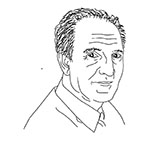Biografia e critica
Biography and critical
ITALIANO
Nasce a Modica (RG) nel 1951. Frequenta l’Istituto d’Arte di Comiso (RG), il Corso Superiore di Disegno Industriale di Venezia e la Facoltà di Architettura di Venezia, dove si laurea nel 1976. Ha insegnato Progettazione Grafica e Tecniche dell’Illustrazione all’Istituto d’Arte di Venezia. Collabora con la Scuola Internazionale di Grafica di Venezia come docente di “Tecniche del Visual”. Lavora come illustratore freelance per Agenzie di Pubblicità e Case Editrici. Ha illustrato e pubblicato libri, cartelle di incisioni e partecipato a mostre in Italia e all’estero. Opera, principalmente, nel campo della pubblicità e dell’editoria per l’infanzia, scolastica e scientifica. È sposato con Francesca ed è papà di Giovanni e Damiano.
Pietro Ricca illustra un suo mondo spaziando liberamente dall’antico al moderno, filtrando le immagini attraverso il suo particolare punto di vista di osservatore arguto ed originale. Che si tratti di soggetti letterari o di illustrazioni ironiche di costume, di scene di genere o di paesaggi simbolici, l’arte di Ricca è sempre un’arte di “idee” che si manifesta con un linguaggio incisivo e tagliente. Più che la lettura sensibile della realtà e le impressioni cromatiche, che Ricca sapientemente coglie a colpo d’occhio, ciò che conta veramente per la sua arte è la consapevolezza intellettuale, capace di trasformare le immagini in metafore o in equivalenti formali. L’opera xilografica di Ricca è quella che a mio avviso mette in luce più significativamente la sua sorprendente capacità di sintesi grafica e di percezione cromatica reale ed immaginaria. Queste caratteristiche si accentuano in particolare con la disciplina stessa della Stampa a Rilievo (intaglio su legno o linoleum), che richiede all’incisore di esprimersi attraverso il puro contrasto del bianco e del nero, in un linguaggio a tinte forti ed espressive, che Ricca sembra privilegiare. L’abilità nell’intaglio, l’intuizione, la sensibilità e soprattutto “l’idea” sono gli ingredienti che fanno della grafica di Ricca un’arte densa di vitalità e di impatto comunicativo. Ciò che continua a stupire nelle immagini di Ricca è quanto armoniosamente possano fondersi assieme la più antica e tradizionale delle discipline di stampa ed il più attuale e diretto dei linguaggi espressivi.
Matilde Dolcetti
ENGLISH
He was Born in Modica (RG) in 1951. He attended the Art Institute in Comiso (RG), the Advanced Course of Industrial Design and the Faculty of Architecture in Venice, where he graduated in 1976. He taught Design and Technique of Illustration by the Art Institute of Venice. He works with the International Graphic School of Venice as professor of Visual Technique. He works as freelance illustrator for advertising agencies and publishers. He illustrated and published books, folders of carvings and took part in exhibitions in Italy and abroad. He is active mainly in advertising and publishing for children, educational and scientific publishing. He is married to Francesca and he is Giovanni and Damiano's dad.
Pietro Ricca illustrates his own world moving freely from the ancient to the modern style, filtering the images through his particular point of view, tipical of a witty and original observer. His art, whether it be literary character or ironic illustrations of traditions or scenes of daily life or symbolic landscapes, is always an art of “ideas” that displays itself by an effective and edgy language. More than a sensitive interpretation of reality and the chromatic impressions, wich Ricca catches at a glance, what really matters to his art is the intellectual awareness, able to convert images in metaphor or in equivalent forms. In my opinion Ricca’s xylographic work is the one that highlights more closely his surprising ability of graphical syntesis and real/imaginary chromatic perception. These characteristics increase particulary with the discipline of Raised Printing (wood or linoleum carving) that requires to the engraver to express through the pure contrast of black and white: a hard and expressive dyes’ language that Ricca seems to favour. The ability in carving, the intuition, the sensitivity and especially the “idea” are the ingredients that make Ricca’s graphic an art dense of vitality and comunicative impact. The thing that still surprises in Ricca’s images is how the most ancient and traditional printing discipline and the most present and direct expressing language can merge harmoniously.
Matilde Dolcetti

